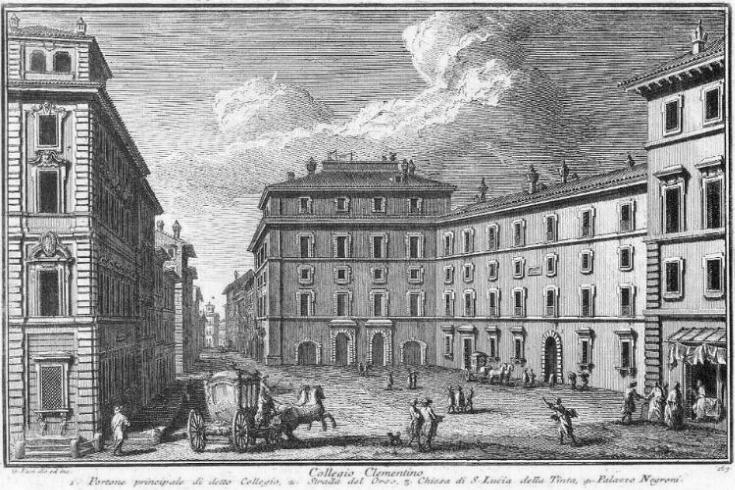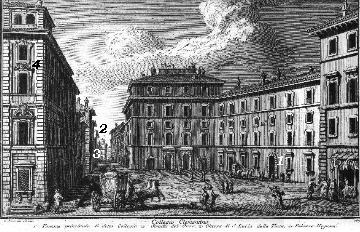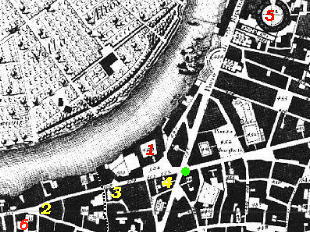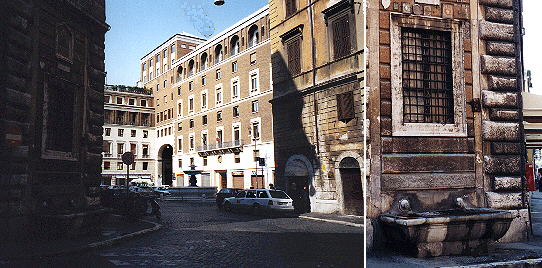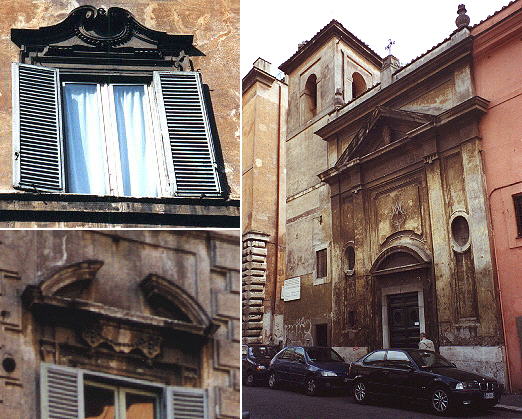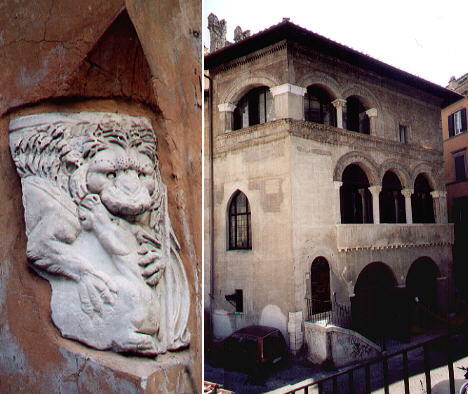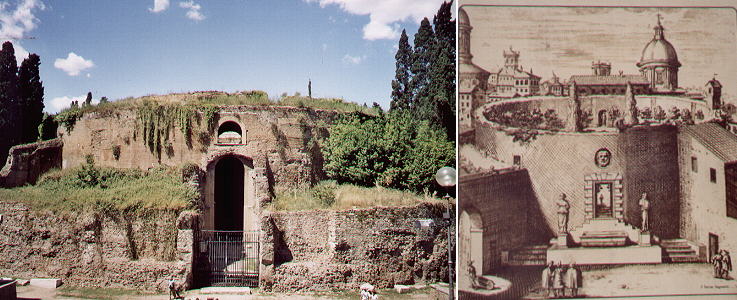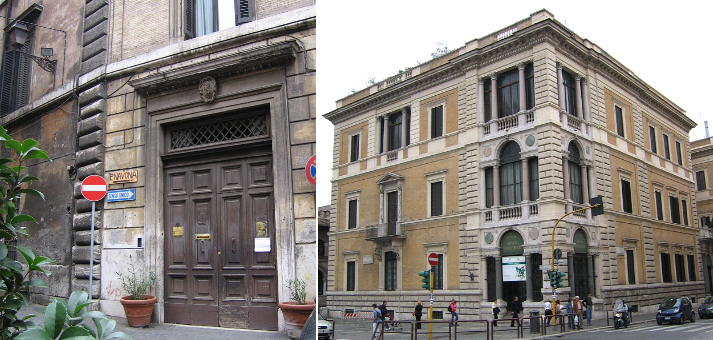

Collegio Clementino (Book
9) (Map
C2) (Day 4) (View C5) (Rione Ponte) and (Rione Campo Marzio)
In this page:
The plate by Giuseppe Vasi
Today's view (including S. Lucia della Tinta)
Strada e Albergo dell'Orso
Mausoleo di Augusto
Palazzo Primoli
The Plate (No. 167)
The College was founded by Clemens VIII to host Slavonian refugees,
but Urbanus VIII made it an exclusive school for the richest families in
Rome. The view is taken from the green dot in the 1748 map below.
In the description below the plate Vasi made reference to: 1) Main entrance to Collegio Clementino; 2) Strada dell'Orso (bear); 3) S. Lucia della Tinta; 4) Palazzo Negroni.
The map shows also 5) Mausoleo di Augusto; 6) Palazzo Primoli. The dotted line in the small map delineates
the border between Rione Campo Marzio (right) and Rione Ponte (left).
Today
The old building has been replaced by a new one in a totally different
style and a fountain (see my background), which once was in Piazza
del Popolo was moved to the square (Piazza Nicosia) opposite Collegio Clementino in 1940. The fountain had been removed from Piazza del Popolo in 1823 and
relocated opposite S. Pietro in Montorio. Later on it was removed again and kept in the municipal warehouse. The fountain shows the eagles and the dragons of Paulus V Borghese, but the original
fountain had only the dragons of Gregorius XIII Boncompagni. The eagles were added
by the 1940 Mayor of Rome, who was a member of the Borghese family. The only evidence of Vasi's time is
the little fountain and some of the windows of Palazzo Negroni.
The church mentioned by Vasi (S. Lucia della Tinta) was spared by the many changes made in the area.
S. Lucia is called "della Tinta" (dye) because many dyers
lived nearby (as you can see from the map, the river is not far from the church).
Strada e Albergo dell' Orso
Near the church there is a street Strada dell'Orso named after a Roman relief showing a bear (it is actually a lion).
The area was near Porto di Ripetta and it was known for its cheap inns and brothels.
One of the surviving medieval buildings is today a very expensive restaurant. It suffers from an excess of restoration.
In the XVIth century it was an excellent inn (Albergo dell'Orso) and it was mentioned by Michel de Montaigne in his
Voyage en Italie (1580-81), but in the XVIIIth century it mainly catered for coachmen.
Mausoleo
di Augusto
The 1883 Baedeker gave the following description of the Mausoleum
of Augustus "On a huge substructure, which contained the mortuary chambers,
arose a mound of earth in the form of the terraces, embellished with cypresses,
surmounted by a statue of the emperor, and environed with a park. In the
Middle Ages it was converted into a fortress by the Colonnas; and a theatre
is now fitted up within its precincts."
In the 1930s the glorification of the Roman Empire led the Fascist
Government to the decision of freeing what was left of the original building
from all later additions, including the theatre (see top right corner of
the map). The new large square is surrounded by modern buildings and it
is now called Piazza Augusto Imperatore (in the past it was named Piazza
degli Otto Cantoni).
Palazzo
Primoli
Palazzo Primoli has two faces. It was built in the XVIth century and its main entrance was in Piazza
dell'Orso. In 1886 the area was modified by the quays which prevented the Tiber from flooding.
A few years later, the owner of the palace, Count Giuseppe Primoli, who had married a member of the
Bonaparte family, enlarged it and built a new façade in a XXth century Renaissance style. He donated his collection of paintings, statues and other memorabilia of the Bonaparte to
the City of Rome to form what is now called Museo Napoleonico.
Excerpts from Giuseppe Vasi 1761 Itinerary related to this page:
Mausoleo di Augusto
Poco dopo entrando nel vicolo detto de' Pontefici per alcune immagini, che sono poste nel prospetto
di un casamento, si trova a destra il palazzino oggi del March. Correa, e nel cortile si vede un misero
avanzo, del celebre mausoleo di Augusto, eretto nel sesto suo consolato per sepoltura di se, de' suoi,
ed ancora di tutti gl'imperatori suoi successori. Era di figura circolare con 12. porte, conforme ai 12. segni
celesti, e tutto ricoperto di bianche pietre lavorate a guisa di rete, ed era diviso a tre piani alto 250.
cubiti; nella sua sommità era posta la statua di Augusto fatta di metallo, e sotto eranvi delle stanze
con finestrelle da riporvi le ceneri, come oggi si vedono. Da piedi fino alla cima era tutto ricoperto di
alberi di perpetua verdura, ed era cinto di tre ordini di mura con una porta e due obelischi, e dietro vi era
un boschetto con deliziose strade da spasseggiare, coperte di pioppi. Ora non vi è rimasto altro, che il
masso di mezzo, ridotto ad uso di giardino pensile; per lo quale tutta la contrada dicevasi ne' secoli
scorsi in Augusta, e furono quivi disotterrati li due obelischi egizi, che ora si vedono, uno eretto
presso la tribuna di s. Maria Maggiore, e l'altro a giacere incontro al palazzo Barberini.
Collegio Clementino, e Chiesa di s. Gregorio
Porta un tal nome questo collegio, perchè eretto da Clemente VIII. l'anno l1595. per benefizio
de' giovani Schiavoni, come dicemmo, ivi questa contrada abitanti: ma dipoi essendo questi da
Urbano VIII. trasportati nella città di Loreto, quivi si ricevono giovani nobili di qualunque nazione,
e sono instruiti in tutte le scienze, ed arti cavalleresche da' religiosi Somaschi. Nella strada a sinistra di
questo collegio, vi è la piccola chiesa di s. Gregorio fondata l'anno 1527. da una confraternita di
Muratori; e nella strada a destra evvi la
Chiesa di s. Lucia della Tinta
Dall'antico tempio di Dite, e Proserpina prese corrottamente il suo nome questa piccola, ed
antichissima chiesa, dedicata a s. Lucia matrona romana, la quale quivi insieme con s. Giminiano
ricevette il martirio. Fu insigne collegiata, ma mancata questa fu governata dal solo Paroco per molto
tempo, e dopo varj riattamenti finalmente fu rimodernata, e decorata di una piccola collegiata di
Canonici dal Principe Borghese.
Or per dire qualche cosa dell'accennato tempio di Dite, e Proserpina: secondo che si legge in varj autori
antichi, era quivi un altare sotterraneo, come alli Dei infernali costumava farsi dalli Pagani, e fu
fatto da' Romani, nella guerra contro gli Albani, ed acciocchè ad ogni altro, fuor che a' Romani,
restasse incognito, fu ricoperto di terra, nè si scopriva se non ne' giuochi secolari, nel qual tempo
vi si celebrava il trinozio.
La piazza, e la strada si dice dell'Orso, per l’immagine di
quell'animale, che ivi
sta in un angolo di un casamento, o per l’insegna dell'albergo, in cui fanno
particolare residenza i calessieri, e vetturini.
|
Next plate in Book 9: Collegio Nazzareno
Next step in Day 4 itinerary: Chiesa di S.
Niccolò de' Perfetti
Start your tour of Rione Ponte: next step: Torre Scapucci
Next step in your tour of Rione Campo Marzio:
Chiesa di S. Carlo al Corso

Go
to  or to Book
9 or to my Home
Page on Baroque Rome or to my Home Page on Rome
in the footsteps of an XVIIIth century traveller.
or to Book
9 or to my Home
Page on Baroque Rome or to my Home Page on Rome
in the footsteps of an XVIIIth century traveller.
|


